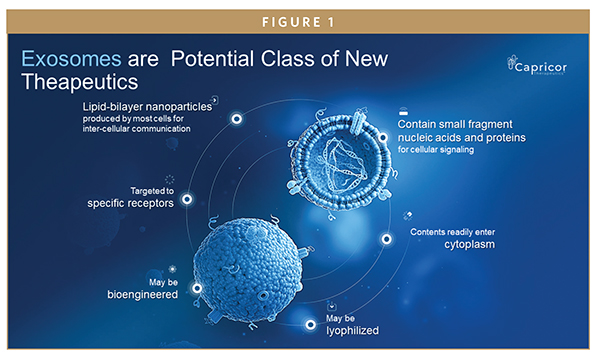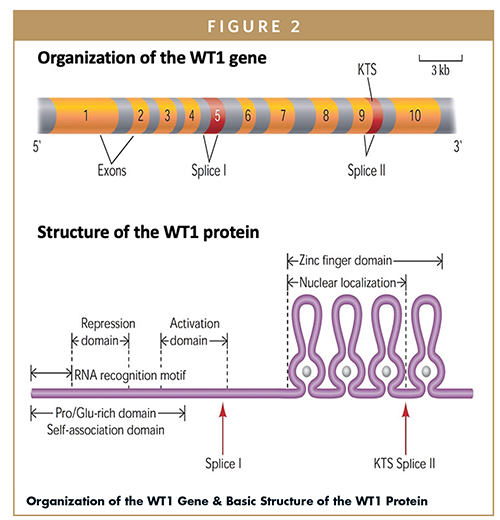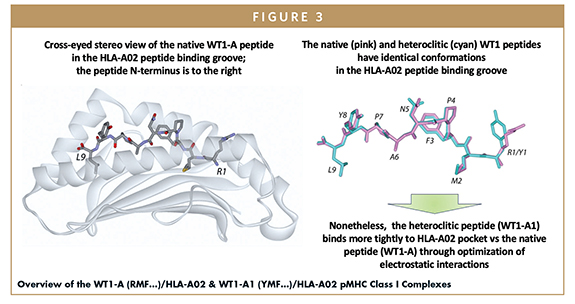Issue:January/February 2022
EXOSOMES - The Next Evolution in Therapy Delivery Beyond the Cell Membrane: The Promise of Exosomes
INTRODUCTION
The business of biotechnology has always been the pursuit of new frontiers; what’s next is always impossible until the breakthrough that makes it possible.
The challenge is that innovative ideas and applications are often difficult for people to understand. While most medical professionals know the top 10 selling pharmaceuticals today are antibodies, it’s easy to forget the earliest recombinant humanized monoclonal IgG1 antibody therapies like Avastin struggled to get approval, because the science surrounding such biologics was so new.

Yet the frontiers in antibodies and other biologic therapeutics that have evolved over the past 3 decades have improved millions of lives for patients with certain types of cancers, to multiple sclerosis, to HIV, arthritis, and anemia associated with chronic renal failure and beyond.
The next frontier in biotechnology is to push beyond the cell membrane and develop therapeutics that target directly inside the cell. The therapeutic opportunities are both obvious and compelling. If we can understand how to safely and reliably target specific cell types, move past the cell membrane, and introduce a critical missing protein — or a set of critical missing proteins — into the cell, we have the potential for a platform that can address many types of diseases and conditions, from diabetes to monogenic diseases, such as cystic fibrosis or Duchenne muscular dystrophy and beyond.
The world has just had a glimpse of this new reality. The recent successes of the mRNA COVID-19 vaccines now being successfully injected into arms across the globe are an important evolutionary step forward in therapy delivery. mRNA medicines are not small molecules, like traditional pharmaceutical drugs, nor are they traditional biologics (such as recombinant proteins and monoclonal antibodies) – which were the origins of the biotech industry. Rather, mRNA medicines are sets of instructions that direct cells in the body to make all the proteins required for life, as well as to prevent or fight disease.
BioNTech/Pfizer’s and Moderna’s mRNA vaccines both use lipid nanoparticles as mRNA carriers. These vaccines rely on the delivery of mRNA into the cytoplasm of host cells, where it can be transcribed into antigenic proteins to trigger the production of neutralizing antibodies. Therefore, mRNA vaccines require a delivery vehicle that not only protects the nucleic acid from degradation, but allows the mRNA to get into cells.1
The answer was to pack the mRNA into protective lipid nanoparticles (LNPs) that would then carry the mRNA into the cells. Once inside the cells, the mRNA instructions teach the cells to make a harmless piece of what is called the “spike protein” found on the surface of the virus that causes COVID-19. Once the protein piece is made, the cell breaks down the instructions and eliminates them.

Next, the antigen presenting cell (APC) displays the protein piece on its surface together with major histocompatibility complex (MHC). Our immune systems recognize that the protein doesn’t belong there and begin building an immune response and making antibodies, like what happens in natural infection against COVID-19. By the end of the process, our bodies have learned how to protect against future infection.
Since a promising delivery system like lipid nanoparticles has been demonstrated to work at scale, why does the world need to keep pushing the frontier?
While the scientific community has recognized the power of RNA as a mediator of disease modification, the conundrum of delivery has haunted the field. While lipid nanoparticles, which have been in development for upward of 30 years, are a good start, they by no means will be the end game in terms of therapeutic development of intracellular drug delivery, and the great frontier of personalized medicine.
The need to continually push the frontier is self-evident: the development of new and better therapies depends entirely on fundamental research. Discovery is a journey that has no end. So, it is fascinating that the problem of delivery of therapeutics could be solved by nature. Perhaps the best way to get past the cell membrane is to deliver contents the same way that cells send information to each other. And that is by the exosome, which in the case of targeted therapy delivery, has been identified as an alternative that shows powerful promise.
WHAT ADVANTAGES COULD EXOSOMES OFFER THAT LIPID NANOPARTICLES DO NOT?
mRNA strands are not only fragile, but they are large and negatively charged. Exosomes are a bigger carrier. mRNA is three to four orders of magnitude larger than molecules that readily diffuse into cells. Second, exosomes can help mitigate the dense negative charge of mRNA. That charge electrostatically repulses the anionic cell membrane, preventing its uptake. Lastly, unlike lipid nanoparticles, exosomes aren’t toxic. The toxicity of lipid nanoparticles isn’t a problem for a COVID-19 vaccine that only requires one or two doses. But it’s unlikely to be a good strategy for a therapeutic that must be delivered monthly or even more frequently. While there is real work ahead, significant progress has already been made.
WHAT ARE EXOSOMES?
Exosomes are nano-sized, membrane-enclosed vesicles that are secreted by essentially all cells and contain bioactive molecules, including proteins, RNAs, and microRNAs. Exosomes are found in all body fluids including blood, saliva, urine, and breast milk. For example, a patient who receives a blood transfusion safely receives trillions of exosomes.
As Dr. Stephen Gould, PhD, Professor of Biological Chemistry at Johns Hopkins University and Capricor Executive Consultant explains, “Exosomes are the body’s natural way of sending complex signals between cells and tissues. As a result, exosome-based vaccines have the potential to elicit more effective immune reactions against infectious agents and cancers, while exosome-based therapeutics have the potential to stabilize drugs and deliver them to their intended site of action.”

Initially, scientists believed exosomes were simply a means of cellular waste disposal. However, further analysis, which took almost a decade, showed that the contents of the exosome were not trash but rather were mediators of cellular behavior. To put it plainly, exosomes are the words of cells. They are how cells communicate to each other and give each other the tools to deal with injury or disease.
Later, science discovered that exosomes may aid in disease diagnosis. A liquid biopsy of exosomes can reveal their complex cargo, and a multicomponent analysis may help doctors understand both disease progression and how well the patient is responding to therapy.
The past decade has witnessed a nearly tenfold increase in publications (115 in 2006, 1,010 in 2015). This growing body of studies indicate a functional, targeted, mechanism-driven accumulation of specific cellular components in exosomes, suggesting that they have a role in regulating intercellular communication — particularly at times of injury.2 Put more colloquially, exosomes can serve as an addressable delivery carrying a “repair toolbox” of proteins, RNAs, and lipids from one cell to another at the moment that cell needs it. What’s more, RNA in exosomes is protected from RNase degradation and is stable under various temperature and pH conditions.3
An exosome, as a single unit, is far more complicated than any typical signaling molecule and is packed with dozens to hundreds of different proteins and different RNAs. What makes exosomes an attractive therapeutic delivery vehicle or a vaccine template is that concentrations of the molecules on the exosomes don’t change relative to one another as they travel away from the point source. This means when one cell wants to send multifactorial signals to other cells doing it via an exosome is far more efficient and effective.
It enables enhanced signaling from a single molecule — rather than the cell interacting with one growth factor, an exosome can deliver signals from dozens or hundreds of individual copies of that one molecule.
It’s also possible to enable multi-dimensional signaling because multiple signaling molecules can be placed on the surface.
Essentially, there are three potential uses for exosomes as pharmaceutical agents. First, they can be collected as a sample from a person’s blood and used as a biomarker of potential pathogenesis. One very important use of exosomes in this way is to determine if cancer is ready to or has metastasized. Measurement of internal contents of the exosome can sometimes predict cancer progression before any other way is measurable. There is an entire field developing around exosome diagnostics.
Another way to use exosomes is to harness the endogenous healing power of a specific cell type. For instance, Capricor has a cell therapy product, CAP-1002, which has known immunomodulatory and regenerative properties. It has been shown that the mechanism of action of the cells are via release of exosomes from the infused cells that travel to sites of injury and stimulate anti-inflammatory and healing pathways. Many companies are pursuing this angle as it allows the benefits of cell therapy without the fragility of using living cells.
Finally, perhaps the best way to use exosomes is as nature’s delivery system. Throughout this review, we have discussed the power and potential of the exosome as a delivery system for RNA’s, proteins, and even lipids (fats). This is the most complicated way to use exosomes, but the path that has the greatest potential benefit. Custom loaded exosomes can lead to biological impact that is designed specifically. It essentially becomes a magic bullet of therapy, delivering the contents inside the cell, which can lead to a variety of translational and post-translational modifications, the ramifications of which are relatively long lasting and targeted.
Exosomes act as messengers to regulate the functions of neighboring cells. Preclinical research has shown that exogenously administered exosomes can direct or, in some cases, re-direct cellular activity, thereby supporting their therapeutic potential. Their size, ease of crossing cell membranes, and ability to communicate in native cellular language makes them an exciting, emerging class of potential therapeutic agents.
Further, it is believed that a selective packaging mechanism is involved in the loading of exosomes, but such a mechanism has not yet been demonstrated. It has been suggested that it may be based, in part, on RNA “zip codes,” that are used by the cell to actively place RNAs in their proper positions in the cell, but this has not yet been proven.4
WHAT WOULD MAKE AN IDEAL DELIVERY VEHICLE FOR THERAPEUTIC TREATMENTS?
Broadly, an ideal delivery vehicle for therapeutic treatments should follow Hippocrates dictum to “do no harm.” More specifically, it should:
- Be specific to the targeting sites with low toxicity to other organs
- Offer high encapsulation and delivery efficiencies
- Protects the payload while in circulation
- Maintain a steady release profile
- Be easy to store, handle, reconstitute, and administer
Exosomes meet most or all of these criteria quite well.

LIPID NANOPARTICLES VERSUS EXOSOMES
Why use an exosome when lipid nanoparticles (LNP) are easy to make, easy to quality assure and control, and are inexpensive? The answer is that LNPs may not be as safe for repeated delivery. There are known consequences of toxicity of the LNP and furthermore, the immune system may ultimately reject the LNPs in a repeated delivery therapeutic paradigm. Taken together, the need for safe and effective ways to get bioactive molecules inside the cell is highly warranted. Furthermore, engineering of an LNP may not be a cost-effective solution compared to engineering of an exosome. Exosomes are a likely candidate to fill this gap in the development of novel biotherapies.

OTHER ADVANTAGES OF EXOSOMES
Targeting
Exosomes are driven to deliver cargo to specific recipient cells, due to the unique membrane proteins and lipids that can bind to specific receptors at the recipient cells, thus enhancing the delivery efficiency. The most common mechanism for targeted drug delivery is membrane fusion via a ligand-receptor interaction. Exosomes and other extracellular vesicles are thought to interact with the plasma membrane of target cells by rolling, followed by binding of specific vesicle membrane proteins with their cell receptors, fusion to the target plasma membrane, and release of cargo molecules into the cytoplasm.5
Low Toxicity to Other Organs
Exosomes have not shown evidence of toxicity to the spleen or liver and do not seem to cause a pathologic immune response.
Ease of Storage & Handling
Because exosomes are a cell-free substance, they can be stored, handled, reconstituted, and administered in a similar fashion to common biopharmaceutical products such as antibodies.
Encapsulation & Delivery
Capricor is developing a precision-engineered exosome platform technology that can carry defined sets of effector molecules that exert their effects through defined mechanisms of action. These have potential for use in vaccine development, vesicle-mediated protein therapies, and treatment of inherited diseases.
Payload Protection
Exosomes are low-immunogenic in nature — the immune system does not attack them because they are similar in composition to the body’s own cells.
Release Profile
As methodologies are developed to manufacture exosomes, critical quality attributes will be easy to establish as will quantification of bioactivity. This assures a standard release profile and a well-defined mechanism of action.
WHAT’S NEXT FOR EXOSOMES?
While exosomes hold powerful promise and deserve the scientific and pharmaceutical industry attention they are receiving, there are challenges that remain to be fully overcome:
- As of today, there is limited to no large scale production of exosomes. Large scale production of exosomes will require more efficient and optimized production and purification strategies.
- First in-human clinical trials will define the critical path forward, which will encompass how rigorously regulators want to define quality attributes.
- Loading exosomes with cargo is possible, but that leading to correction of a disease process has yet to be shown
THE FUTURE IS NOW
Harnessing the power of our own bodies has been the goal of biotechnology for decades. The latest frontier is to get across the cell membrane safely to drive protein expression with long lasting effects on function.
First, it was antibody therapy where we can use the immune system to our advantage to treat a wide array of diseases. Now we are looking deeper to fix errors of metabolism or genetic mutations by using the efficient and effective cellular machinery already in our own bodies. The hurdle has been to get beyond the cell membrane, and now, at last, we have that opportunity with the exosome. Exosomes are slated to change the way medicines are developed and diseases are treated. We are excited to participate in that journey and look forward to breaking down the barriers of treating pathologies associated with intracellular errors.
THREE THINGS TO CONSIDER DOING NOW
- Begin reviewing the available scientific studies and papers. There is a high level of global interest in the subject, and a growing number of resources available.
- Consider what practical uses exosomes might have for potential therapies in or entering your pipeline.
- Open conversations with the industry leaders working to advance the state of the art. Share your requirements and concerns, and ask them what they’re learning and what’s possible today.
REFERENCES
- Let’s talk about lipid nanoparticles. Nat Rev Mater 6, 99 (2021). https://doi.org/10.1038/s41578-021-00281-4.
- https://science.sciencemag.org/ ontent/367/6478/eaau6977#abstract-1.
- S. Hagiwara, P. Kantharidis, M.E. Cooper, MicroRNA as biomarkers and regulator of cardiovascular development and disease. Curr. Pharm. Des., 20, (2014), 2347– 2370. https://www.ingentaconnect.com/content/ben/cpd/2014/00000020/00000014/art00012.
- https://califesciences.org/tiny-exosomes-show-huge-potential-clinical-medicine/.
- Prada, I. & Meldolesi, J. Binding and fusion of extracellular vesicles to the plasma membrane of their cell targets. Int. J. Mol. Sci. 17, pii: E1296, https://doi.org/10.3390/ijms17081296 (2016).

Dr. Linda Marbán is the Chief Executive Officer of Capricor Therapeutics, a clinical-stage biotech company developing novel cell and exosome-based therapeutics for the treatment of diseases. As co-founder of Capricor, Inc., its wholly-owned subsidiary, she has been with Capricor, Inc. since 2005 and became its Chief Executive Officer in 2010. She combines her background in research with her business experience to lead the company and create a path to commercialization for its novel therapies. Dr. Marbán’s deep knowledge of the cardiac space, in particular, allows her to provide unique direction for the company’s development and growth. From 2003 to 2009, she was with Excigen, Inc., a biotechnology start-up company, where she was responsible for business development, operations, preclinical research, and supervising the development of gene therapy products in a joint development agreement with Genzyme Corp. Dr. Marbán began her career in academic science, first at the Cleveland Clinic Foundation working on the biophysical properties of cardiac muscle, and continued into to a postdoctoral fellowship at Johns Hopkins University (JHU). She earned her PhD from Case Western Reserve University in Cardiac Physiology.
Total Page Views: 8333











